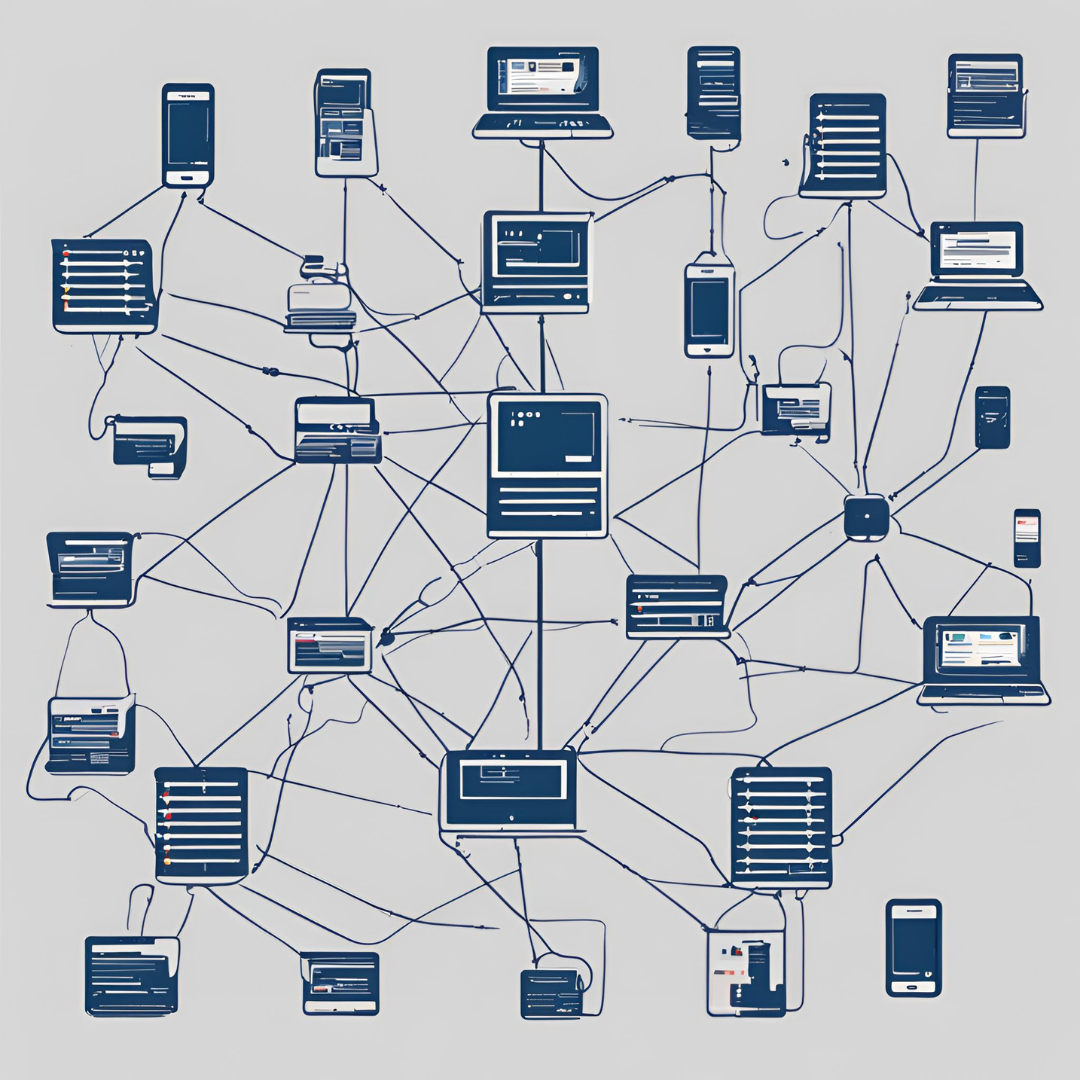Blockchain and decentralized technologies are reshaping the digital landscape by providing innovative solutions to long-standing problems in various industries. These technologies offer enhanced security, transparency, and efficiency, fundamentally altering how we conduct transactions, manage data, and interact with digital systems. In this blog, we will explore the fundamentals of blockchain, the rise of decentralized technologies, key applications, and the future potential of this transformative paradigm.
Understanding Blockchain Technology
Blockchain is a revolutionary technology that transforms the way we record and verify transactions. It operates across a vast network of computers, ensuring the data's security, transparency, and permanence. Every transaction is bundled into a block, and these blocks are then interconnected, forming a continuous chain - the essence of "blockchain."
Key Components:
-
Decentralization: In contrast to conventional centralized systems where a single authority manages the database, blockchain functions on a dispersed network of interconnected nodes. Every node in this network holds a complete copy of the blockchain, providing data backup and safeguarding against potential failures.
-
Transparency: In the realm of blockchain technology, every recorded transaction is open for all network members to view, promoting a sense of transparency. Public blockchain networks, such as Bitcoin and Ethereum, are designed to be accessible to everyone, enabling the open verification of all transactions that occur within the system.
-
Immutability: Blockchain technology offers a unique solution to the challenge of data integrity. Once a new block is added to the blockchain network, modifying the information within that block becomes an extremely difficult task. This is because any alteration would require changing all the subsequent blocks as well, and that can only be achieved through the agreement of the majority of the network participants. This inherent immutability of the blockchain guarantees the trustworthiness and reliability of the data recorded within the system.
How Blockchain Works:
-
Transaction Initiation: A person starts a financial operation, which is then shared with the entire network.
-
Validation: In the world of blockchain technology, network participants, known as miners or validators, play a crucial role in verifying and validating the transactions that occur on the network. They utilize consensus mechanisms, such as Proof of Work (PoW) or Proof of Stake (PoS), to ensure the integrity and security of the blockchain. These consensus mechanisms serve as the backbone of the network, enabling the collaborative validation of transactions and the maintenance of the shared digital ledger.
-
Block Creation: Verified transactions are collected and organized into a cohesive unit known as a block. This block serves as a container, housing the validated transactions and ensuring their secure and transparent recording within the blockchain network.
-
Consensus: The block gets incorporated into the blockchain once there is an agreement among the network participants.
-
Record Keeping: The transaction gets recorded permanently in the digital ledger, where all members of the network can view it.
The Rise of Decentralized Technologies
Decentralized systems built on blockchain technology empower users by eliminating the need for a central governing body. This fosters greater self-governance and reduces dependence on third-party intermediaries. Prominent manifestations of this decentralized approach include decentralized applications (dApps), decentralized finance (DeFi), and decentralized autonomous organizations (DAOs), all of which exemplify this shift towards more autonomous and self-directed digital ecosystems.
Key Decentralized Technologies:
-
dApps: Blockchain-based applications leverage distributed networks to automate operations and facilitate transactions through the use of smart contracts. Unlike conventional software, these decentralized applications are open for public access, function on peer-to-peer architectures, and are resilient to censorship attempts.
-
DeFi: Decentralized finance, or DeFi, is revolutionizing the way we access financial services. These innovative platforms provide lending, borrowing, trading, and investment opportunities, all without relying on traditional financial institutions like banks. By leveraging the power of blockchain technology and smart contracts, DeFi platforms deliver transparent, efficient, and widely accessible financial solutions to users. Eliminating the need for intermediaries, these decentralized platforms empower individuals to take control of their financial activities, fostering a more inclusive and equitable financial ecosystem.
-
DAOs: Decentralized autonomous organizations (DAOs) are entities that operate without centralized control. They are guided by self-executing digital agreements, known as smart contracts, rather than traditional human leadership. These innovative structures empower stakeholders to collectively make decisions and manage shared resources. Members can vote on proposals and implement changes, fostering a democratic and transparent approach to organizational governance.
Key Applications of Blockchain and Decentralized Technologies
-
Cryptocurrencies:
-
Bitcoin: Bitcoin, the pioneering digital currency, functions as both a medium of exchange and a means to preserve wealth. Uniquely, it operates in a decentralized manner, enabling direct transactions between individuals without the involvement of third-party intermediaries.
-
Ethereum: Ethereum's blockchain technology takes the concept of cryptocurrency a step further by allowing the execution of smart contracts and the development of decentralized applications (dApps). This expansion opens up a vast array of possibilities, moving well beyond the basic functionality of digital currency transactions.
-
-
Supply Chain Management: Decentralized finance systems provide financial services akin to those offered by traditional institutions, but without the need for conventional middlemen like banks. These systems leverage smart contracts built on blockchain networks to deliver financial services that are transparent, efficient, and readily available to users. Lending, borrowing, trading, and investing can all be facilitated through these decentralized platforms, which eliminate the reliance on traditional financial intermediaries.
-
Example: Food safety and quality are guaranteed by IBM's Food Trust blockchain infrastructure, which tracks food products from farm to table.
-
-
Healthcare: Blockchain protects patient information, improves healthcare system interoperability, and guarantees data integrity. Patients maintain control of their medical records, and when necessary, authorized doctors can access correct data.
-
Example: Patients may securely manage and share their health information using MedRec, a medical record management system built on blockchain technology.
-
-
Voting and Governance: By lowering the possibility of fraud and guaranteeing accurate vote counting, blockchain technology can enhance the transparency and integrity of voting systems. Because decentralized decision-making is made possible by DAOs, organizational governance is also being revolutionized.
-
Example: Voatz is a blockchain-based voting software that makes sure voting procedures are safe and substantiable throughout elections.
-
-
Digital Identity: Blockchain technology offers a self-sovereign and secure digital identification solution, empowering people to manage their identity data and communicate it directly with reliable parties.
-
Example: Users may safely create and manage their digital identities with uPort, an identity management system built on blockchain technology.
-
-
Real Estate: Blockchain reduces fraud and streamlines real estate transactions by offering transparent and unchangeable records of property ownership and transactions.
-
Example: Propy is a blockchain-based technology that registers real estate deals on the blockchain to streamline real estate transactions.
-
-
Intellectual Property: Blockchain helps creators preserve and profit from their work by offering a tamper-proof record of ownership and provenance, thereby safeguarding intellectual property rights.
-
Example: Imogen Heap, a musician, established Mycelia, a platform that uses blockchain to manage royalties and music rights so that artists are fairly compensated
-
Conclusion
Blockchain and decentralized technologies are transforming industries by offering secure, transparent, and efficient solutions. From cryptocurrencies and supply chain management to healthcare and digital identity, these technologies are unlocking new possibilities and empowering individuals. While challenges remain, ongoing research and innovation are paving the way for a future where blockchain and decentralized technologies play a central role in our digital lives. Embracing these technologies can lead to more equitable, efficient, and resilient systems, ultimately shaping a more decentralized and connected world.





Leave a Reply